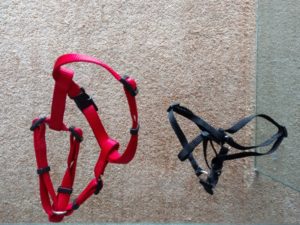Leash training a cat: is every cat trainable?
I don’t think all cats are equal. Being a life-long cat lover and owner I felt the very first moment I saw Ipek: this kitty is different. The 5-month old kitten was very active, intelligent, curious and showed a dog-like behavior. He even growled and barked like a dog.
Does it depend on a breed? Ipek is a mix, most likely he has some Siamese blood. I guess it is not as much the race as the character. Outgoing, curious, people-oriented, not easily scared. By the way, these are exactly the same character traits which made me keep him indoors. Ipek is not street-wise. Instead of being cautious of cars he has a strange attraction to them. I saved him from under a car once. And he also welcomes other people so that he can be grabbed by anyone. So he should never be allowed to roam the streets freely. Even in our Dutch small town, where cats are allowed to get outdoor any time they like. My other two cats do it too, proudly using their cat door. But they are different cats and it is a different story.

Leash training a cat: choosing a harness
Ipek got his first harness when he was 6 months. Not for walking in the first instance, but as extra security for travel. The first harness was a cheap 8-type band and quite tricky to use. This is when I learned Lesson #1. Practice the harness so that you can put it on the cat from the first attempt. Because the kitty won’t give you a second chance.
Now Ipek has a better one, the Trixie Hunter, which is quite a good value for the money. Yet it is not 100% escape-secure. Even if all bands are perfectly adjusted the cat can squirm out of the harness by twisting his body. Though he can only do it when moving backward. It means he needs some kind of a pivot, like a stem of a tree or any other pole. Watch out: your cat should never wrap the leash around such a “pivot’ that allows him to wriggle backward and escape.
One day I will buy Ipek a holster-chest harness for longer and more exciting trips. For the time being, we are fine with the H-type Trixie.
Leash training a cat: the first steps.

Actually, these are not steps. It is standing and waiting until the kitty gets comfortable with the harness. Lesson # 2. Choose the best time, place and mood. The cat must be neither too hungry nor too full. In the latter case, he won’t move and go anywhere. It would be difficult to tempt and reward him with snacks. Ideally, the first walk should be made in the backyard. And not while the neighbor is mowing his lawn with his noisy mowing machine. The weather should be fine, the atmosphere – serene and relaxed. The cat must be in the right mood: neither too sleepy like in the late afternoon, not too wild like at sunset or dawn. Around noon was the best time for Ipek.
As you can see, at first he was not moving at all. Just getting used to his attire. Then I learned Lesson # 3. Patience.

Leash training a cat: around the house
Very soon Ipek started moving around on a leash. Sometimes I tied my ‘goat’ to a pole, keeping a close eye on him. I could do some gardening chores while he was staring at the ducks in the pond or chasing bumblebees.
However, several times when I was too busy gardening Ipek managed to break out and run away to the neighbors’ garden. We have no fences with the neighbors, neither are our gardens separated from the street. I was considering enclosing our garden. Not the best idea since our two other cats are free roamers.
After a couple of escapes, I realized that leaving him unattended is like leaving a small child out of sight when he is playing in the sandbox. Besides a leash makes a cat extra vulnerable. So there came Lesson #4. Keep a close eye on your cat when he is on a leash.
Leash training a cat: into the wild
Finally, we started walking out into the street in front of our house. There is a little bush just opposite the house. People walk their dogs there. The vegetation is bushy and rough. Tall oaks are towering over the pristine bush. Our municipality calls it a “forest-park” and does minimalistic grooming. This is why mice and rats thrive. Smokey – our other cat – loves hunting there.
So I thought the wilderness might be interesting for Ipek. And yes, he was interested. I had to follow him through the impenetrable bushes because Lesson # 5 is: Follow your cat, let him lead you and not vice versa.
The cat’s two main instincts are quite conflicting: freedom and need for safety. Lesson #6 is to fulfill both of these instincts. A long retractable lead gives him enough freedom to explore. But always hold it short when nearing a road or a dog passing by. Learn how to distinguish which instinct is prevalent at the moment. Read the body language of your cat. Watch his eyes, ears, fur on the back and tail movements. For instance, I noticed that even the sound of my feet stamping on the dry leaves behind his back can scare Ipek. So now I am trying not to make any noise behind his back. If I do, I say his name. I also learned to offer him my shoulder to fly on, if Ipek wants to use me like a tree.
The biggest risk of leash-walking in the wild is when a cat freaks out. We have a saying in Dutch about a cat who becomes unpredictable when being pushed towards the edge. Some specialists claim that leash-walking adds stress because it deprives the cat of the sense of control. This is why you should minimize stress by choosing a quiet spot and time to walk with your feline friend. And doing it regularly at the same time of the day. Routine is stress-diminishing.
Last but not least. Enjoy. See and experience the world through the cat’s eyes. Explore the world where every shrub provides intelligence info. Every passing car (dog, bike rider) can be a threat. Every tree can be an opportunity. Become one with your cat. Feel the bond. This is Lesson #7.
Leave a Reply